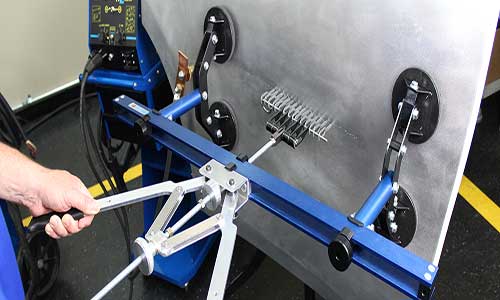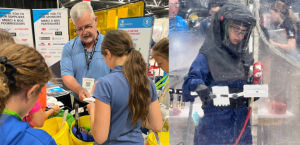Differences between materials impact the repair process and the results.
Have you heard about the 2015 Aluminum F-150? Of course you have. Aluminum is the topic du jour and the hype is only escalating.
When new technologies or big changes come along in the collision repair industry, hysteria and shady sales pitches are sure to follow. Aluminum has been used for vehicle construction for decades but this resurgence will have some significant impacts. The most significant will be the new equipment cost.
From hand tools to welders and riveters, many big ticket tools will be required to repair the F-150 or any other aluminum vehicle. There will be some lower cost alternatives in some cases. Ford will not require a permanent aluminum clean room but will recommend at the least a curtained off area. Please follow Ford’s recommendations.
Some special tools and equipment will be necessary but most products and materials that are used for steel can be used for aluminum. There may be differences such as abrasive grade adjustments but 3M’s position, with very few exceptions, is that all materials currently used for steel can be used for aluminum as long as they are used in accordance with directions for use. It is also important that tools and materials used for steel are kept separate to avoid contamination.
The same seam sealers, body sealers, undercoats and abrasives can be used on both substrates. Just knowing that drastic material changes will not be necessary should alleviate a great deal of anxiety. The difference lies not in the products and materials, but in the repair process itself.
The physical properties of aluminum are different than that of steel. Steel has a memory when bent or deformed and has a tendency to go back to its original shape during the repair process. With steel, heat can aid in the reforming process but may not be recommended on many of today’s high strength steels.
Conversely, aluminum has a tendency to remain in its current shape or remain deformed when damaged. The grain structure of aluminum differs from that of steel because it is much less inclined to realign during the repair process, and unlike steel, aluminum should always be heated during straightening.
This can make repairs difficult and require different equipment and more finesse and patience. If the aluminum is accidentally stretched while repairing, the panel is no longer repairable. Aluminum dent pulling systems should allow you to keep pulling pressure applied while the damaged area is heated and massaged back into shape. The equipment is very different and more expensive but the materials are still the same in most cases.
Most premium body fillers and glazes contain high-quality adhesion promoters and are approved for use on aluminum when directions and standard operating procedures are observed. These premium fillers can be used on bare aluminum or over epoxy primer as some OES require.
When sanding, follow the grade recommendations of the OE, which will generally recommend a finer grade when working on aluminum vs. steel and never coarser than grade 80.
Special aluminum compatible abrasives are not necessary, but never use the same sheet of sandpaper on aluminum if it was previously used on steel. The abrasives are the same but it is a good idea to segregate them in separate cabinets according to metal substrate.
Some technicians may think that because aluminum doesn’t rust, corrosion protection is less important or even unnecessary. Sealing repaired joints tightly during repairs is very important to prevent oxidation and corrosion from occurring.
Applying protective coatings like anti-chip coatings and undercoating is also necessary to protect the aluminum body. Stone chips can start the corrosion process on aluminum by allowing oxidation to creep under the paint fi lm and cause blisters known as filiform corrosion. After heating or using dent pulling equipment on aluminum, a cavity wax must be used to re-seal the surface of the aluminum on the back side. The back sides of any welded joints also need to be coated with a cavity wax. The corrosion protection process is very similar to that of steel, and the products that can be used are the same. No specially formulated seam sealers, rust-proofing or anti-chip coatings are required. The same products can be used if the directions for use are followed.
Some materials are equally effective when it comes to aluminum panel bonding and steel panel bonding, although the process is slightly different for each. For example, 3M panel bonding adhesive is compatible and OE approved for both aluminum and steel. 3M panel bonding adhesive has been used to bond aluminum panels for nearly 20 years and is specifically recommended by ford for the repairs to the 2015 aluminum f-150. In the case of 3M, panel bonding adhesives undergo extensive testing to be specified by an OE, so there is no question about its ability to bond aluminum parts successfully.
Aluminum has been used for vehicle construction for decades but this resurgence will have some significant impact, the most significant of which will be the new equipment cost. From hand tools to welders and riveters, there will be many big ticket tools that will be required to repair the f-150 or any other aluminum vehicle.
With aluminum and other different substrates soon to arrive, you’re going to have to handle the car with hygiene in mind. Even with a curtained work area it’s likely steel particles will make their way to the aluminum. Clean the panels immediately before applying any coatings or fillers.
The use of self-generated vacuum tools can keep particles to a minimum while keeping the equipment spend down. Evaluate needs and determine what can be done with existing equipment.
It remains to be seen how the adjustment to mainstream aluminum repairs will go for collision repair shops. Many shops have made similar adjustments in the past and are well prepared to make this change without much difficulty. The advent of waterborne paints had an impact on the paint shop whereas the aluminum change will impact the metal shop and leave the paint shop, for the most part, unscathed. There may be small adjustments in the paint shop but nothing major.
The other good news is that the allied materials needed for aluminum will also change very little, though some marketing campaigns may say otherwise. You will not have to deal with wholesale changes or many additional part numbers for materials, which frees you up to spend your time sorting out equipment needs and making sure you’ve received adequate training.
TACKLING ALUMINUM REPAIRS?
HERE ARE KEY THINGS YOU NEED TO KNOW
You will need some special tools, but many standard tools and products will work.
• separate your tools and work areas to avoid contamination.
• The science of the substrate drives the process.
• Always follow standard operating procedures!
• Corrosion protection is critical.
• Use this opportunity to review your habits.
• Now is the time to train yourself for tomorrow’s repairs.
• Always follow OE recommendations.
























